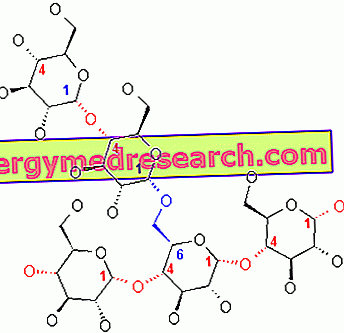Glycogen is a macromolecule (molecular mass of about 400 million daltons) of α-glucose in which there are mainly α-1, 4 glycosidic bonds and branches in a ratio of 1:10, due to α-1, 6 glycosidic bonds.
The glycogen constitutes reserve material and is continuously degraded and reconstituted; in all the body cell mass, we have about 100 g of glycogen: most of it is in the liver where it is mobile and can, therefore, be used as a reserve for the other organs (glycogen in the muscles is not mobile).
The enzymes that catalyze the degradation and synthesis of glycogen, are all in the cytoplasm, therefore a regulation system is needed that makes one route inactive when the other is active: if glucose is available, the latter is converted into glycogen (anabolism) which is a reserve, conversely, if glucose is required, then glycogen is degraded (catabolism).

The enzyme mainly involved in the degradation of glycogen is glycogen phosphorylase ; this enzyme is able to cleave an α-1, 4 glycosidic bond using, as a lytic agent, an inorganic orthophosphate: the cleavage takes place via phosphorolytic and glucose 1-phosphate is obtained.
At five or six units from a branching point, the enzyme glycogen phosphorylase is no longer able to act, therefore it detaches from glycogen and is replaced by a debranching enzyme which is a transferase : in the catalytic site of this enzyme there is a 'histidine which allows the transfer of three saccharidic units to the nearest glycosidic chain (histidine attacks the first carbon of a glucose molecule). The enzyme just mentioned is glycosyltransferase ; at the end of the action of this enzyme, only one glucose unit remains on the side chain with the first carbon bound to the sixth carbon of a glucose in the main chain. The last glucose unit of the side chain is released by the action of the α-1, 6 glycosidase enzyme (this enzyme is the second part of the debranching enzyme); given that the branches, in glycogen, are in a ratio of 1:10, from the complete degradation of the macromolecule we obtain about 90% of glucose 1-phosphate and about 10% of glucose.
The action of the aforementioned enzymes allows the elimination of a side chain from the glycogen molecule; the activity of these enzymes can be repeated until there is complete degradation of the chain.
Let's consider a hepatocyte; glucose (assimilated through the diet), when it enters the cell it is converted to glucose 6-phosphate and is thus activated. Glucose 6-phosphate, by the action of phosphoglucomutase, is transformed into glucose 1-phosphate: the latter is a non-immediate precursor of biosynthesis; in biosynthesis, an activated form of sugars is used, which is represented by sugar bound to a diphosphate: usually uridyldiposphate (UDP). The glucose 1-phosphate is then converted into UDP-glucose; this metabolite is under the action of glycogen synthase which is able to bind UDP-glucose to a non-reducing end of the growing glycogen: elongated glycogen is obtained from a glucosidic unit and UDP. UDP is converted by the enzyme nucleosidedifosphokinase into UTP which returns to the circulation.
Degradation of glycogen occurs by the action of glycogen phosphorylase which releases a glucose molecule and transforms it into glucose 1-phosphate. Subsequently, phosphoglucomutase converts glucose 1-phosphate to glucose 6-phosphate.
Glycogen is synthesized, above all, in the liver and in the muscles: in the body there are 1-1.2 grams of glycogen distributed throughout the muscle mass.
The glycogen of a myocyte represents a reserve of energy only for that cell while the glycogen contained in the liver is also a reserve for the other tissues, that is, it can be sent, as glucose, to other cells.
The glucose 6-phosphate obtained in the muscles from the degradation of glycogen is then sent, in the case of energy requirements, to glycolysis; in the liver, glucose 6-phosphate is converted into glucose by the action of glucose 6-phosphate phosphatase (an enzyme characteristic of hepatocytes) and is conveyed into the circulatory stream.
Both glycogen synthase and glycogen phosphorylase work on the non-reducing units of glycogen, so there must be a hormonal signal that commands the activation of one pathway and the blocking of the other (or vice versa).
In the laboratory it was possible to lengthen the glycogen chain, exploiting glycogen phosphorylase and using glucose 1-phosphate in very high concentration.
In cells, glycogen phosphorylase only catalyzes the degradation reaction because the concentrations of the metabolites are such as to shift the balance of the following reaction, to the right (ie towards the degradation of glycogen):

Let's look at the mechanism of action of glycogen phosphorylase: acetalic oxygen (which acts as a bridge between glucose units) binds to phosphoryl hydrogen: a reaction intermediate is formed by a carbocatione (on glucose which is extremity) to which the phosphoryl (Pi) binds very quickly.
Glycogen phosphorylase requires a cofactor which is pyridoxal phosphate (this molecule is also a cofactor for transaminases): it has a phosphoryl protonated only in part (pyridoxal phosphate is surrounded by a hydrophobic environment that justifies the presence of protons bound to it) . Phosphoryl (Pi) is able to yield a proton to glycogen because such phosphoryl regains then, the proton from the partially protonated phosphoryl of the pyridoxal phosphate. The probability that, at physiological pH, the phosphoryl loses the proton and remains completely deprotonated is very low.
Now let's see how phosphoglucomutase works. This enzyme has a phosphorylated serine residue in the catalytic site; serine yields phosphoryl to glucose 1-phosphate (in position six): glucose 1, 6-bisphosphate is formed for a short time, then serine is rephosphorylated by taking phosphoryl in position one. Phosphoglucus mutase can work in both directions, i.e. convert glucose 1-phosphate to glucose 6-phosphate or vice versa; if glucose 6-phosphate is produced, it can be directly sent to glycolysis, into the muscles, or transformed into glucose in the liver.
The enzyme uridyl phosphoglucus transferase (or UDP glucose pyrophosphorylase) catalyzes the transfer reaction of glucose 1-phosphate to UTP by phosphoryl attack a.
The enzyme just described is a pyrophosphorylase: this name is due to the fact that the opposite reaction to that just described is a pyrophosphorylation.
UDP glucose, obtained as described, is able to lengthen the glycogen chain of a monosaccharide unit.
It is possible to evolve the reaction towards the formation of UDP glucose by eliminating a product which is pyrophosphate; the enzyme pyrophosphatase converts pyrophosphate into two orthophosphate molecules (hydrolysis of an anhydride) and by doing so, keeps the concentration of pyrophosphate so low that the UDP glucose formation process is favored thermodynamically.
As mentioned, UDP glucose, thanks to the action of glycogen synthase, is able to lengthen the glycogen chain.
The ramifications (in a ratio of 1:10) are due to the fact that, when a glycogen chain consists of 20-25 units, a branching enzyme (having a histidine on its catalytic site) intervenes, capable of transferring a series of 7 -8 glycosidic units further downstream of 5-6 units: a new branching is thus generated.
For reasons of nervous origin or if energy is needed due to physical effort, adrenaline is secreted from the adrenal glands.
The target cells of adrenaline (and norepinephrine) are those of the liver, muscles and adipose tissue (in the latter there is the degradation of triglycerides and the circulation of fatty acids: in the mitochondria it is, therefore, produced glucose 6 -phosphate, to be sent to glycolysis, while in adipocytes, glucose 6-phosphate is transformed into glucose by the action of the enzyme glucose 6-phosphate phosphatase and exported to tissues).
Let's see, now, the mode of action of adrenaline. The adrenaline goes to bind to a receptor placed on the cell membrane (of myocytes and hepatocytes) and this determines the translation of the signal from outside to inside the cell. The protein kinase is activated which acts simultaneously on the systems that regulate the synthesis and degradation of glycogen:
Glycogen synthase exists in two forms: a dephosphorylated form (active) and a phosphorylated form (inactive); the protein kinase phosphorylates glycogen synthase and blocks its action.
Glycogen phosphorylase can exist in two forms: an active form in which a phosphorylated serine is present and an inactive form in which the serine is dephosphorylated. Glycogen phosphorylase can be activated by the enzyme glycogen phosphorylase kinase . Glycogen phosphorylase kinase is active if it is phosphorylated and inactive if it is dephosphorylated; the protein kinase has as substrate the glycogen phosphorylase kinase, i.e. it is able to phosphorylate (and, therefore, activate) the latter which, in turn, activates glycogen phosphorylase.
Once the adrenaline signal is over, the effect it has in the cell must also end: phosphatase enzymes intervene, then, on the protein species.



